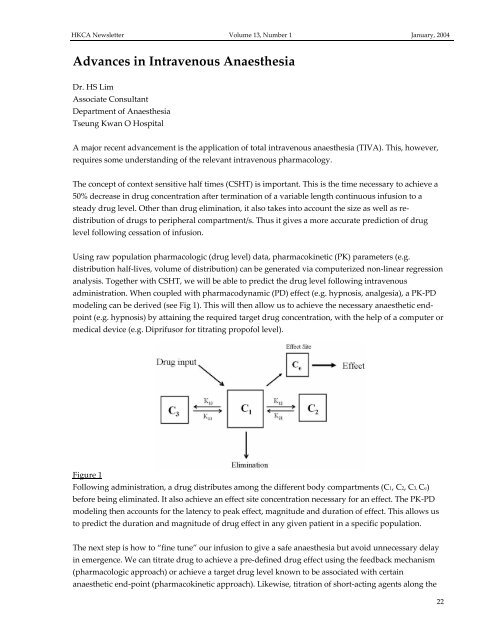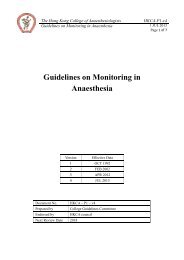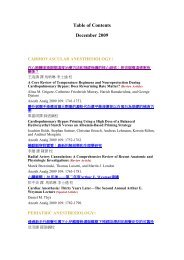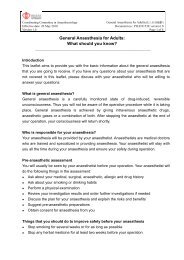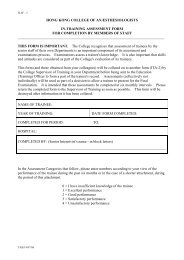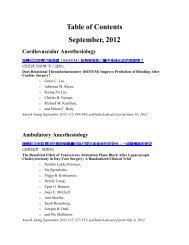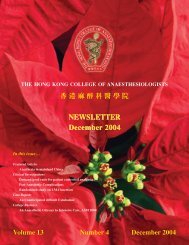HKCA Newsletter, Volume 11, No.1 - The Hong Kong College of ...
HKCA Newsletter, Volume 11, No.1 - The Hong Kong College of ...
HKCA Newsletter, Volume 11, No.1 - The Hong Kong College of ...
- No tags were found...
You also want an ePaper? Increase the reach of your titles
YUMPU automatically turns print PDFs into web optimized ePapers that Google loves.
<strong>HKCA</strong> <strong>Newsletter</strong> <strong>Volume</strong> 13, Number 1 January, 2004Advances in Intravenous AnaesthesiaDr. HS LimAssociate ConsultantDepartment <strong>of</strong> AnaesthesiaTseung Kwan O HospitalA major recent advancement is the application <strong>of</strong> total intravenous anaesthesia (TIVA). This, however,requires some understanding <strong>of</strong> the relevant intravenous pharmacology.<strong>The</strong> concept <strong>of</strong> context sensitive half times (CSHT) is important. This is the time necessary to achieve a50% decrease in drug concentration after termination <strong>of</strong> a variable length continuous infusion to asteady drug level. Other than drug elimination, it also takes into account the size as well as redistribution<strong>of</strong> drugs to peripheral compartment/s. Thus it gives a more accurate prediction <strong>of</strong> druglevel following cessation <strong>of</strong> infusion.Using raw population pharmacologic (drug level) data, pharmacokinetic (PK) parameters (e.g.distribution half‐lives, volume <strong>of</strong> distribution) can be generated via computerized non‐linear regressionanalysis. Together with CSHT, we will be able to predict the drug level following intravenousadministration. When coupled with pharmacodynamic (PD) effect (e.g. hypnosis, analgesia), a PK‐PDmodeling can be derived (see Fig 1). This will then allow us to achieve the necessary anaesthetic endpoint(e.g. hypnosis) by attaining the required target drug concentration, with the help <strong>of</strong> a computer ormedical device (e.g. Diprifusor for titrating prop<strong>of</strong>ol level).Figure 1Following administration, a drug distributes among the different body compartments (C1, C2, C3, Ce)before being eliminated. It also achieve an effect site concentration necessary for an effect. <strong>The</strong> PK‐PDmodeling then accounts for the latency to peak effect, magnitude and duration <strong>of</strong> effect. This allows usto predict the duration and magnitude <strong>of</strong> drug effect in any given patient in a specific population.<strong>The</strong> next step is how to “fine tune” our infusion to give a safe anaesthesia but avoid unnecessary delayin emergence. We can titrate drug to achieve a pre‐defined drug effect using the feedback mechanism(pharmacologic approach) or achieve a target drug level known to be associated with certainanaesthetic end‐point (pharmacokinetic approach). Likewise, titration <strong>of</strong> short‐acting agents along the22


